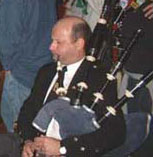

Renfrew (Rinn Friù in Scottish Gaelic) is a town, located six miles west of Glasgow on the west coast of Scotland. It was the county town of the county of Renfrewshire until 1975. From 1975 to 1996 it was within the Renfrew district of the Strathclyde local government region. It is now in the unitary council area of Renfrewshire.
The town is located at the confluence of the River Clyde and the River Cart. A passenger ferry crosses the Clyde to Yoker and a swing bridge crosses the Cart to Inchinnan and Glasgow International Airport.
Renfrew is known as the "Cradle of the Royal Stewarts" and held royal burgh status from 1397 until 1975. The current Baron of Renfrew is Prince Charles. Although the town gives its name to the council area of Renfrewshire, the function of administrative capital of the area now falls on the town's larger neighbour Paisley.
The main weekly newspaper for the town of Renfrew is The Gazette which is currently one of Scotland's fastest-growing regional newspapers.
Renfrew is home to the engineering company Doosan Babcock (formerly Babcock and Wilcox) and the Braehead out-of-town retail development.
The shipbuilders Simons and Lobnitz were based in Renfrew. William Simons and Company had begun business elsewhere but settled in Renfrew in 1860. During World War II the rival shipbuilding firm Lobnitz, apart from shipbuilding, designed and built Mulberry Harbours which were used to offload cargo on a beach during the Allied invasion of Normandy. Simons-Lobnitz Ltd was established in 1959 when G & J Weir Holdings Ltd, pump manufacturers, Glasgow, took over Lobnitz & Co Ltd, shipbuilders, Renfrew, Scotland, and merged it with William Simons & Co Ltd, ship and dredger builders, Renfrew, Scotland, which had been acquired by G & J Weir Ltd in 1957. Simons and Lobnitz were famous for building sand dredgers. The Renfrew ship yards closed in the early 1960s. [1] [2]
Sports and recreation
Renfrew was a parliamentary burgh as a component of Glasgow Burghs from 1708 to 1832, and as a component of Kilmarnock Burghs from 1832 to 1918, when it was merged into the East Renfrewshire constituency.


No comments:
Post a Comment